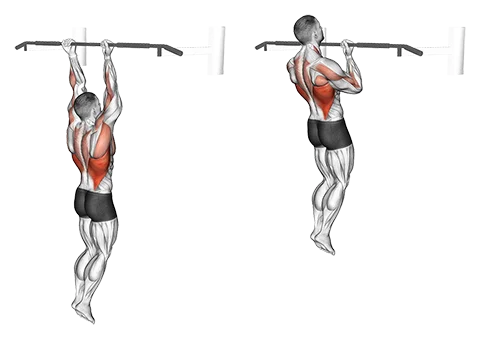Introduction
Exercise "Chin Up" is a classic upper body strength training movement that primarily targets the back muscles (latissimus dorsi), biceps, and forearms. It offers numerous benefits such as increased muscle mass, improved posture, and enhanced grip strength. The chin up exercise is particularly effective for individuals aiming to achieve broad shoulders, a strong upper body, and overall functional fitness.
Muscles Worked
- Primary: Latissimus Dorsi, Biceps Brachii
- Secondary: Deltoids (Rear), Teres Major, Rhomboids, Forearm Flexors (Biceps Brachii)
How to Do It (Step-by-Step)
- Stand under a pull-up bar with a shoulder-width grip, feet off the ground.
- Pull yourself up so that your chin is above the bar.
- Keep your back straight, core engaged, and elbows close to your body during the movement. Avoid swinging or using momentum.
Tip: If you find it difficult to perform a full chin-up at first, consider using an assisted chin-up machine or using a band for assistance.
Rep & Rest Guidelines
- Strength: 4–6 reps, 2–3 min rest
- Hypertrophy: 8–12 reps, 60–90 sec rest
- Endurance: 12–20 reps, 30–60 sec rest
Use Auto Progression Auto Progression to adjust the weight based on your progress.
Set a Rest Timer Rest Timer to ensure optimal recovery between sets.
Form Tips
- Maintain a neutral neck alignment: Avoid tilting or flexing your neck as this can strain the muscles and affect the efficiency of the exercise.
- Position hands correctly: Grasp the bar with an overhand grip, slightly wider than shoulder width apart for most people. This helps to engage the back and shoulder muscles effectively.
- Maintain a tight core: Engage your abdominal muscles throughout the lift to help stabilize your spine and reduce the risk of injury during the exercise.
When to Use It
- Building Upper Body Strength: Chin ups are effective for increasing upper body strength and muscle mass, focusing on the back, biceps, and shoulders.
- Improving Posture: Regular chin up exercises can help correct poor posture by strengthening the muscles between the shoulder blades and improving upper body alignment.
- Enhancing Pull-up Performance: Chin ups are a crucial part of pull-up training, as they help build the necessary strength in the biceps and lower lats for executing pull-ups with proper form.
Workout History can help you track your progress and improve your fitness goals over time.
A chin up primarily works the back, specifically the lats and biceps.
Aim for 3-4 sets with 8-12 repetitions per set, adjusting based on your strength level.
Maintain a shoulder-width grip, pull your body up until your chin reaches the bar, and lower slowly.
It's generally not necessary for chin ups; focus on proper form instead.
Both are beneficial. Chin ups target the biceps more, while pull-ups work the back more.

